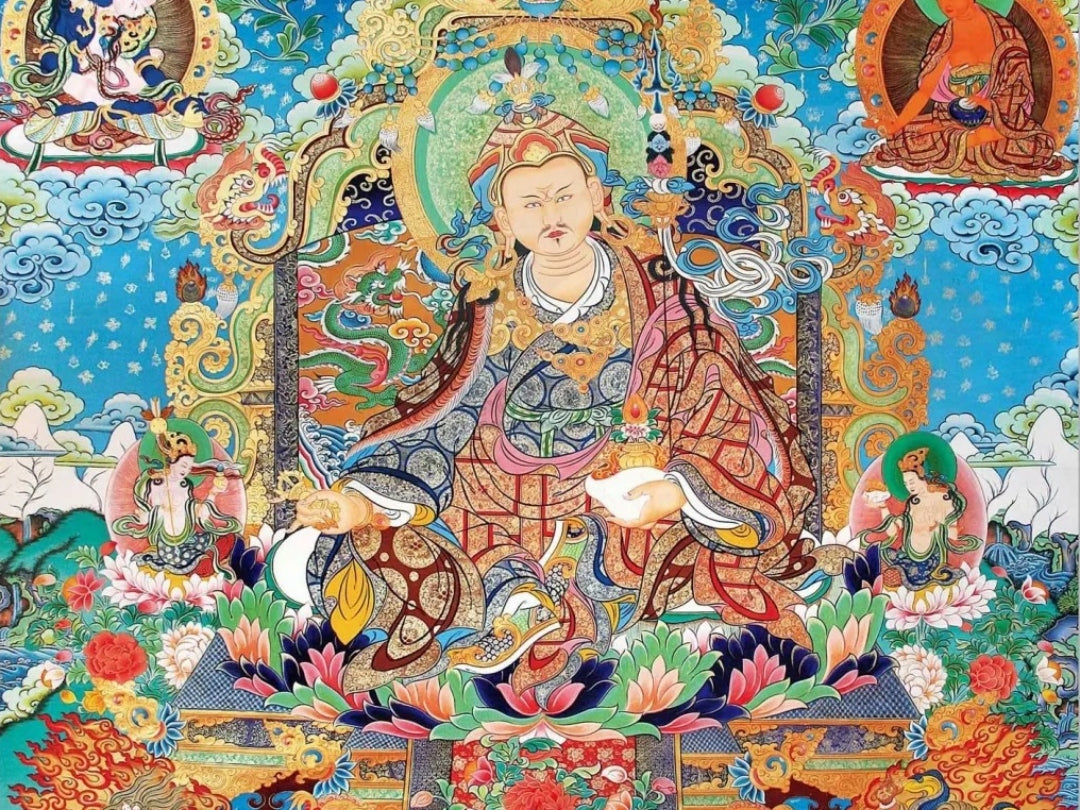In Buddhist jewelry, depictions of Guanyin, particularly the Thousand-Armed Guanyin (Thousand-Armed Avalokiteshvara) and the Four-Armed Guanyin, embody profound symbols of compassion, wisdom, and protection. These representations have deep historical roots and serve as powerful reminders of Buddhist virtues. Let’s explore the origins and meanings behind these sacred figures and how they’re reflected in jewelry today.
The full title of "Thousand-Armed Avalokiteshvara" is "Thousand-Armed, Thousand-Eyed Avalokiteshvara Bodhisattva," one of the six forms of Avalokiteshvara in Buddhism. According to Buddhist belief, the suffering and troubles of sentient beings are varied, and their needs and wishes are different. Thus, boundless power and wisdom are required to save them.

Origins of the Thousand-Armed, Thousand-Eyed Avalokiteshvara
To understand the Thousand-Armed, Thousand-Eyed Avalokiteshvara, let’s explore its origins. In Tibetan culture, several interpretations exist:
-
According to the teachings of Bhavaviveka, Avalokiteshvara made a Bodhisattva vow before Amitabha Buddha. Kneeling, he vowed, "I swear to save sentient beings, especially those of the Snow Region, and to tame even the most unruly beings, ensuring all are liberated without hesitation or slackness. If I fail and falter for personal comfort, let my head split into ten petals, and my body into a thousand fragments like lotus petals." After this vow, Avalokiteshvara traveled to the Snow Region and led countless beings to liberation, sharing the Six-Syllable Mantra to ease their suffering.
Later, Avalokiteshvara returned to Putuo Mount and looked back at the Snow Region, seeing that only a small portion had achieved liberation. Many remained untransformed, with some violent and savage beings becoming even more so. Feeling discouraged, he briefly desired personal ease, which broke his vow. His head shattered into ten pieces, and his body fragmented into a thousand. Avalokiteshvara then prayed to Amitabha, who said, "Disciple, do not despair. I will transform your head into ten, with one additional Amitabha Buddha above, and create a thousand arms for you, each with an eye. With renewed determination, continue guiding sentient beings."
-
In another legend, the Thousand-Armed Avalokiteshvara was originally the third princess of King Miaozhuang in India. The king had three daughters: Miaojin, Miaoyin, and Miaoshan. Miaoshan became a nun from a young age, despite her father’s disapproval. After her father burned down the monastery where she resided, he developed 500 festering sores due to his sins. The cure required the eye and hand of a close relative, which the two elder daughters refused to offer. Miaoshan, however, willingly sacrificed her eye and hand, curing her father’s ailment. Moved by her filial piety, Shakyamuni Buddha said, "You have sacrificed an eye and a hand. I will return them to you as a thousand eyes and hands." Thus, Miaoshan became the Thousand-Armed, Thousand-Eyed Avalokiteshvara, and her temple at Baoding Mountain became a revered site.
The Thousand-Armed Avalokiteshvara has eleven heads, the same as the Eleven-Faced Avalokiteshvara. The front eight arms each hold an item, including hands in prayer, beads, a lotus, a dharma wheel, a purification vase, and a bow and arrow. The additional countless hands each bear an eye, forming a radiating effect symbolizing Avalokiteshvara’s power to see and protect all beings. The thousand hands signify universal compassion, while the thousand eyes represent omniscience and boundless mercy.

The Four-Armed Avalokiteshvara
The Four-Armed Avalokiteshvara is a highly esteemed deity in Tibetan Buddhism and holds an exalted status among Tibetan people. Tibetans deeply believe that their region's transformation and progression toward civilization are inseparable from Avalokiteshvara's influence, honoring him as a guardian deity.
The Four-Armed Avalokiteshvara, along with Manjushri and Vajrapani, is part of the "Three Bodhisattva Protectors" of the Snow Land, representing the qualities of "compassion, wisdom, and power." These qualities are also known as the "Three Jewels" essential for Tibetan Buddhist practitioners. In Tibetan art, particularly in Thangka paintings, the Four-Armed Avalokiteshvara is a widely represented subject, with symbolic elements that make the conceptual ideas visually tangible.

The Four-Armed Avalokiteshvara’s statue has a single face and four arms, conveying a serene and dignified expression. His single face reflects the Dharma's nature, free from idle discourse, while his four arms embody the Four Immeasurables—loving-kindness, compassion, joy, and equanimity:
- Loving-kindness: May all beings experience happiness and its causes.
- Compassion: May all beings be free from suffering and its causes.
- Joy: May all beings never be separated from happiness.
- Equanimity: May all beings remain unbiased, free from attachment or aversion.
The four arms also symbolize the four Buddha activities: pacifying (overcoming obstacles), increasing (enhancing virtues and longevity), attracting (guiding beings), and subjugating (overcoming inner and outer hindrances).
Each hand holds meaningful items:
- The right hand holds crystal prayer beads, representing Avalokiteshvara’s constant recitation of mantras, freeing beings from the cycle of suffering.
- Central hands hold a wish-fulfilling jewel at chest level, symbolizing his wish to help all beings transcend samsara.
- The left hand raises a lotus blossom, signifying purity, detachment from worldly concerns, and Avalokiteshvara's pure, virtuous heart dedicated to aiding those in need.
Sitting in a vajra posture on a lotus, Avalokiteshvara signifies unwavering meditation, unity of wisdom and compassion, and the non-dual nature of samsara and nirvana.

The Thousand-Armed and Four-Armed Guanyin figures remain enduring symbols in Buddhist jewelry, representing compassion, wisdom, and protection. Whether seen in a thangka necklace or a pendant, these sacred images connect wearers to Buddhist teachings and bring peace, protection, and a reminder of boundless compassion into daily life.




